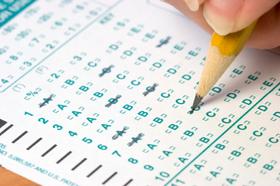Standardized tests are a common way to assess student performance and academic achievement in K-12 schools. Schools use several types of standardized tests to evaluate different aspects of student learning.
Here are some key aspects that standardized tests evaluate:
Content Knowledge
Standardized tests assess students' understanding of the subject, including key concepts, facts, and vocabulary. They aim to measure how well students have grasped the content taught at their grade level or across multiple years.
Application of Skills
These tests evaluate students' ability to apply their knowledge to solve problems and analyze information. They assess critical thinking, reasoning, and problem-solving skills essential for academic success.
Reading Comprehension
Standardized tests often include passages or questions about reading comprehension. They measure students' ability to understand and interpret written texts, including identifying main ideas, making inferences, and evaluating arguments.
Writing Skills
Some standardized tests include writing components, where students must express their ideas coherently, use appropriate grammar and vocabulary, and organize their thoughts effectively. These sections evaluate students' written communication skills.
Quantitative Reasoning
Mathematics is a fundamental subject assessed in standardized tests. They gauge students' understanding of mathematical concepts, procedures, and problem-solving abilities. The tests may cover various areas, such as arithmetic, algebra, geometry, statistics, and data analysis.
Scientific Inquiry
Tests in science subjects assess students' understanding of scientific concepts and ability to apply scientific inquiry methods. They evaluate skills like observation, experimentation, data analysis, and drawing conclusions based on evidence.
Test-Taking Skills
Standardized tests also measure students' ability to navigate the test format and answer questions within a given time frame. These skills include following instructions, managing time effectively, and eliminating incorrect options through the process of elimination.
It's important to note that standardized tests have limitations and may not fully capture a student's overall abilities, creativity, or other non-academic skills. However, they serve as a tool for assessing academic progress, identifying areas of improvement, and providing a standardized measure for comparing student performance across schools, districts, and states.
Common standardized tests
Here are the standardized tests commonly used in the United States.
National Assessment of Educational Progress (NAEP)
The National Assessment of Educational Progress (NAEP) is a federally funded test administered to a sample of students in each state. The test assesses student knowledge in various subjects, including reading, mathematics, and science. The results of the NAEP monitor student performance trends and compare performance across different regions of the country.
Scholastic Aptitude Test (SAT) and Preliminary Scholastic Aptitude Test (PSAT)
The Scholastic Aptitude Test (SAT) and the Preliminary Scholastic Aptitude Test (PSAT) are college entrance exams used to assess students' readiness for college-level work. The SAT and PSAT measure reading, writing, and mathematics knowledge and skills. High scores on these tests can increase a student's chances of being accepted into a college or university.
American College Testing (ACT)
The American College Testing (ACT) exam is another college entrance exam that assesses reading, writing, mathematics, and science knowledge and skills. Most colleges and universities in the United States accept ACT results. High scores on the exam can improve a student's chances of being accepted into a college or university.
International Baccalaureate (IB) and Advanced Placement (AP) Exams
The International Baccalaureate (IB) and Advanced Placement (AP) exams assess student knowledge and skills in specific subject areas, such as history, biology, or calculus. Students in advanced courses typically take these exams. They are seeking college credit or advanced standing in a particular subject area.
This video offers an overview of the NAEP test.
State-Specific Standardized Tests
Many states require students to take standardized tests specific to their state. These tests assess student knowledge and skills in reading, writing, and mathematics. Examples of state-specific standardized tests include
- California Assessment of Student Performance and Progress (CAASPP)
- New York State Assessment Program (NYSTP)
- Texas Assessment of Knowledge and Skills (TAKS)
Other common standardized tests used in K-12 schools include
- Measures of Academic Progress (MAP)
- Stanford Achievement Test (SAT)
- Iowa Test of Basic Skills (ITBS)
- Iowa Test of Educational Development (ITED)
Tests like these assess student knowledge and skills in various subject areas and are often used to monitor student progress over time.
This video offers an overview of the Standford Achievement Test.
The History and Evolution of Standardized Tests
We can trace the history and evolution of standardized testing in the United States back to the early 20th century.
Here is an overview of key milestones and developments:
Origins and Early Forms:
- In the late 19th and early 20th centuries, educational reformers such as Horace Mann and John Dewey advocated standardized assessments to measure student achievement.
- The College Entrance Examination Board (CEEB) was established in 1900 to administer a standardized test known as the College Entrance Examination (later renamed the SAT) for college admissions.
The emergence of IQ Testing:
- In the early 1900s, psychology saw the development of intelligence testing, with the Stanford-Binet Intelligence Scale being one of the first widely used tests.
- IQ tests aimed to measure intelligence and mental abilities, and their results were often used to categorize students and guide educational placement decisions.
Introduction of Achievement Tests:
- In the 1920s, achievement tests were introduced to measure students' knowledge and skills in specific subject areas.
- The Iowa Tests of Basic Skills (ITBS), developed in the 1930s, became one of the most widely used standardized achievement tests.
Federal Involvement and Standardized Testing Expansion:
- In 1965, the Elementary and Secondary Education Act (ESEA) became law, marking the first significant federal involvement in education. The Act aimed to improve educational opportunities for disadvantaged students and included provisions for standardized testing to measure progress.
- The National Assessment of Educational Progress (NAEP) was established in 1969 as a national assessment to monitor student achievement in various subjects.
No Child Left Behind Act (NCLB):
- In 2002, the NCLB Act became law. It mandated annual standardized testing in reading and math for students in grades 3-8 and required schools to show Adequate Yearly Progress (AYP) or face consequences.
- NCLB emphasized accountability, set proficiency targets, and led to increased reliance on standardized tests for school evaluation and student promotion.
Shift to Common Core State Standards and Next-Generation Assessments:
- In the 2010s, the Common Core State Standards (CCSS) were adopted by many states, aiming to establish consistent educational standards across the country.
- Along with CCSS, new next-generation assessments were developed to align with the standards. Examples include the Partnership for Assessment of Readiness for College and Careers (PARCC) and Smarter Balanced Assessment Consortium (SBAC) tests.
Every Student Succeeds Act (ESSA):
- In 2015, the ESSA replaced NCLB, providing states more flexibility in designing their accountability systems and reducing the federal emphasis on standardized testing.
- ESSA allowed states to develop their assessment frameworks and placed greater emphasis on multiple measures of student and school performance.
It's important to note that the history of standardized testing in the United States has been marked by ongoing debates and criticisms regarding the limitations and unintended consequences of such assessments, including concerns about the narrowing of curriculum, teaching to the test, and potential biases in testing. Moreover, as education continues to evolve, discussions on the purpose, fairness, and effectiveness of standardized testing remain topics of interest and reform.
Conclusion
In conclusion, many standardized tests are used in K-12 schools, each with a unique purpose and focus. Whether assessing student readiness for college-level work or monitoring student progress in a specific subject area, standardized tests provide a valuable tool for evaluating student performance and academic achievement.
Questions? Contact us on Facebook. @publicschoolreview
#standardizedtests #SAT #ACT #AP #IB #PSAT


















